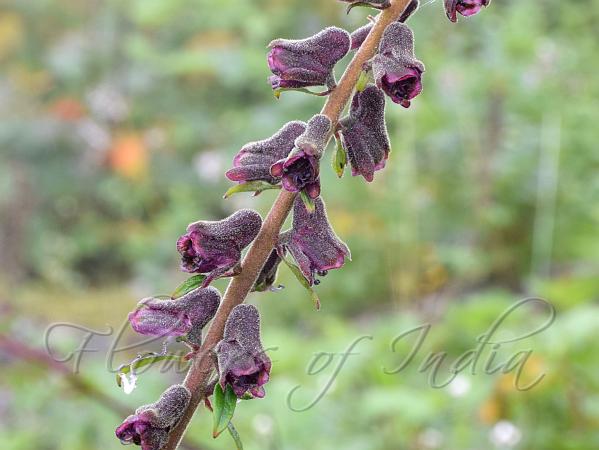|
| Lurid Himalayan Monkshood |
|

|

| File size | 721419 |
| Original date | 8/22/23 2:10 PM |
| Resolution | 4496 x 3000 |
| Flash | Flash did not fire |
| Focal length | 50.0mm |
| Exposure time | 1/60s |
| Aperture | 10.0 |
| Focus Distance | |
| Metering Mode | Spot |
| Camera make | NIKON CORPORATION |
| Camera model | NIKON D5300 |
| Sensor type | OneChipColorArea |
|
|
|
|
Photo: |
Botanical name: Aconitum novoluridum Family: Ranunculaceae (Buttercup family)
Synonyms: Aconitum luridum (nom. illeg.)
Synonyms: Aconitum luridum (nom. illeg.)
Lurid Himalayan Monkshood is a perennial herb with
stem up to 80 cm, simple, velvet-hairy. Flowers are borne at the end of
stem, in about 30 cm long, many flowered spike. Axis and flower-stalks
are densely yellowish velvet-hairy. Proximal flower-stalks are 1-4 cm,
others 1-7 mm. Sepals are lurid, reddish or brownish red to purple,
yellowish
inside, densely velvet-hairy. Lower sepals 0.7-0.9 cm; lateral sepals
1-1.3 cm; upper sepal high galeate, 7-9 mm high, long beaked, lower
margin 1.1-1.5 cm. Petaline lip linear, prominent. Basal leaves are
about 2, and proximal stem leaves long stalked; leaf-stalk 19-23 cm;
leaf blade kidney-shaped, about 6 x 10 cm, both surfaces sparsely
appressed velvet-hairy, 3-parted; central lobe wedge-shaped-rhombic,
3-fid, each lobe 2- or 3-lobulate, with several ovate teeth; lateral
lobes obliquely flabellate, unequally 2-lobed. Seedpods are 1-1.2 cm.
Lurid Himalayan Monkshood is found in forest margins, at altitudes of
3800-4500 m, in East Himalaya, Nepal, Tibet. Flowering: July-August.
| Identification credit: Amber Srivastava | Photographed at Tsomgo Lake, Sikkim. |
• Is this flower misidentified? If yes,